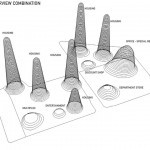Gwanggyo Power Center in South Korea by MVRDV Architects
Since the beginning of the millennium local nodes with a high density concentration of mixed program are used in Korean town planning. These nodes consist of a mix of public, retail, culture, housing, offices and leisure generating life in new metropolitan areas and encouraging further developments around them: the Power Centre strategy. The Gwanggyo Power Centre will consist of 200,000m2 housing, 48,000m2 offices, 200,000m2 mix of culture, retail, leisure and education and 200,000m2 parking.
- Architects: MVRDV Architects
- Project: Gwanggyo Power Center
- Location: Future new town of Gwanggyo, located 35km south of the Korean capital Seoul
- Program: 200,000m2 housing, 48,000m2 offices, 200,000m2 mix of culture, retail, leisure and education and 200,000m2 parking
- Date: 2007-2011 (initial planning)
- Budget: Withheld
- MVRDV: Winy Maas, Jacob van Rijs, Nathalie de Vries with Youngwook Joung, Wenchian Shi, Raymond van den Broek, Paul Kroese, Naiara Arregi, Wenhua Deng, Doris Strauch, Bas Kalmeijer, Simon Potier, Silke Volkert, Marta Pozo, Francesco Pasquale
- Engineering: Arup
- Local Architect: DA Group
This diverse program has different needs for phasing, positioning and size. To facilitate this all elements are designed as rings. By pushing these rings outwards, every part of the program receives a terrace for outdoor life. Plantations around the terraces with a floor to floor circulation system store water and irrigate the plants. The roofs of these hills and the terraces are planted with box hedges creating a strong, recognizable, cohesive park. This vertical park will improve the climate and ventilation, reduce energy and water usage. As a result a series of overgrown green hills appear in the landscape.
The site is surrounded by a beautiful lake and forested hills, the design aims to create a landscape on top of the new program that enlarges the green qualities and that links the surrounding parks by turning the site into a park.
The shifting of the floors causes as a counter effect hollow cores that form large atriums. They serve as lobbies for the housing and offices, plazas for the shopping center and halls for the museum and leisure functions. In each tower a number of voids connect to the atrium providing for light and ventilation and creating semi-public spaces. On the lower floors the atriums are connected through a series of public spaces on various levels linking the towers and serving the outdoor facilities of the culture, retail and leisure program. The Power Centre creates a dense urban program with a green regard.
- Birds eye
- Birds eye Night view
- Cam House scape
- Cam Lake
- Cam Landscape
- Final Booklet
- Final Booklet
- Gwanggyo Power Centre
Dr. EMAD HANI ISMAEEL
Ph.D. in Technologies for the Exploitation
of the Cultural Heritage .
Senior Lecturer in the Dept. of Architecture
College of Engineering , University of Mosul
Mosul - Iraq .
E-mail: emadhanee@yahoo.com
Web Site: http://sites.google.com/site/emadhanee/
Tel : +964 (0)770 164 93 74
















تعليقات
إرسال تعليق